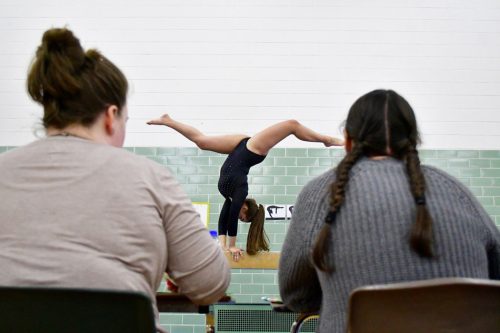Even With Bad Optics, IHSAA Gymnastics Will Soldier On

Aundreya Wegener graduates from Wawasee as the lone senior from a very small squad that will be looking for new coaches next winter. (File photos by Mike Deak)
Editorial Note: This is the first of a two-part series into IHSAA gymnastics and how the sport is holding on both locally and statewide.
SYRACUSE – For years, now-retired Wawasee gymnastics head coach Nika Prather wondered when the phone call would come. When it didn’t, she would show up in the high school annex gym and start the process over again, wondering again a few months later if the phone message of “gymnastics is canceled” would possibly come again.
The sports of gymnastics is quite possibly the most specialized of all the IHSAA sanctioned sports. Of the 22 sports under the IHSAA umbrella, gymnastics and diving are the only two that are scored on opinion. All the skill and talent in the athlete’s performance really becomes the judgment of two individual judges sitting at a small table or school desk, etching what their eyeballs and brains are communicating back and forth on scoresheets. Those sheets of paper are then ushered by (usually kid volunteers) to a scorer’s table, where the score is then transmitted back to the (usually kid volunteers) who then stand and twirl a manual scoreboard at the audience with no explanation of where the score came from.
Coaches then start the predictable dance of running to the scorers, asking why their athlete was slighted, or conversely, dancing little jigs after the athlete performed at or better than expectation. It’s a peculiar sequence of events.
While swimming and diving does require water and a board and its diving judging is done in a similar manner, the sport itself can be practiced in any regard to which deep enough water exists, whether a lake, public or private pool, or at a house.
Gymnastics, however, does not have the same luxuries of just needing a neighbor with a pool or having Lake Wawasee in the backyard. Quick, check in the garage for a vaulting mat and vault. Find one? How about uneven bars with the proper tightening cords? Got a 40×40-foot spring board mat for a floor exercise or a low and high balance beam in the shed?
“Gymnastics is not a sport that you can just decide to do,” Prather said. “Clubs help, but it’s hard to find kids that want to spend the time and be dedicated to sticking with the sport once it gets harder. You don’t just have the equipment available to practice unless you find someone or somewhere that has it.”
Prather has been around the sport for four decades and has seen the sport get a bump every four years after an Olympic push, whether it was Nadia Comenaci, Mary Lou Retton, Kerry Strug or Simone Biles. Yet, none of those athletes have been able to help the declining numbers the sport has seen in the past decade. Per the IHSAA, in the 2009-10 season, there were 86 schools participating in gymnastics with a grand total of 667 athletes on rosters. At the time, there were eight sectionals across the state.

Judges preside over Wawasee gymnast Olivia Ousley’s beam routine earlier this season.
That number has dwindled. The number of sectionals shrunk from eight to six in 2014. In 2018-19, the number of schools were down to 78 and 518 athletes, and this past season, 2019-20, even further to 73 schools but the number of gymnasts were up slightly to 525. However, digging into this past season’s numbers, the concern Prather showed is evident.
Of the teams listed in sectionals this year, only 56 of the 73 schools fielded a full team (four or more). Several of those 56 had just four members. The IHSAA also yielded that of the 412 member schools, the 73 active schools produced just an 18 percent participation rate.
Compared to other girls sports, gymnastics is grossly lagging behind. Of those 412 member schools for the 2019-20 school year in each sport’s state tournament, basketball had 395 teams entered in its sectional. The other winter sport, swimming, had 242 teams. Soccer had 272, softball (using 2018-19 numbers) had 373, and where some argue is the most specialized sport in golf – where partnerships are needed with local courses, equipment is primarily up to the athlete or coach, and practice is dependent on course availability – there were 301 teams entered of the 412 institutions.
“Each year I present to the board our participation numbers, etc. specific to the sport of gymnastics,” noted IHSAA Assistant Commissioner Sandra Walter, who oversees gymnastics as part of her overall duties. “While participation is below 25 percent of our 412 membership, we continue to hold steady with numbers involved in the sport. I will once again present to our board in May. We have no plans to eliminate gymnastics from our sports offered.”
And with a lack of teams, parity has also come into question. Looking at recent state history, the talent gap is growing. Of the 38 sectional team champions with at least five titles, 16 don’t exist anymore, including Marion (22) and both Logansport and Perry Meridian (13 each). Both Marion and Logansport both had teams in the past five years.
Regional titles narrow the list dramatically, where only eight programs have won a regional since 2010, and the blue bloods of today’s gymnastics have won most of them in Valpo and Columbus North (8), Fort Wayne Dwenger (7), and Fort Wayne Carroll and Indianapolis Roncalli (3). Only Chesterton (2), Seymour (1) and Logansport (1) also have regional titles in that time frame. Between Valpo, Chesterton, Dwenger and Columbus North, the four have won 22 of the last 30 state titles.
In the second look on Wednesday, we’ll take a dive into the local Wawasee Sectional and see where some local programs stand.
